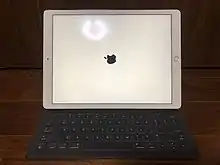 | |
| Developer | Apple Inc. |
|---|---|
| Manufacturer | Foxconn (on contract) |
| Product family | iPad |
| Type | Tablet computer |
| Release date | June 13, 2017 |
| Introductory price | $799 |
| Discontinued | October 30, 2018 (12.9 inch) March 18, 2019 (10.5-inch) |
| Operating system | Original: iOS 10.3.2 Current: iPadOS 17.2, released December 11, 2023[1] |
| System on a chip | Apple A10X with 64-bit architecture and Apple M10 motion co-processor |
| Memory | 12.9-inch 2G, 10.5-inch: 4 GB LPDDR4 SDRAM |
| Storage | 64, 128, 256, or 512 GB[2] flash memory |
| Display | 12.9-inch: 2732×2048 px (264 PPI) (IPS panel) (5.5 megapixels), 12.9 in (327.8 mm) diagonal, 4:3[2] 10.5-inch: 2224×1668 px (264 PPI) (IPS Panel), 10.5 in diagonal, 4:3[2] |
| Graphics | 12-core PowerVR Series 7XT |
| Sound | Four speakers, adjusting sound to device orientation |
| Camera | 12.9-inch 2G and 10.5-inch: 7 megapixels 1080p front-facing and 12 megapixels 4K rear-facing, Optical & Digital Image Stabilization[2] |
| Connectivity | |
| Power | Built-in rechargeable lithium-ion battery |
| Dimensions | 12.9-inch: 305.7 mm (12.04 in) (h) 220.6 mm (8.69 in) (w) 6.9 mm (0.27 in) (d) 10.5-inch: 250.6 mm (9.87 in) (h) 174.1 mm (6.85 in) (w) 6.1 mm (0.24 in) (d) |
| Mass | 12.9-inch Wi-Fi: 677 g (1.493 lb) |
| Predecessor | iPad Pro (1st generation) |
| Successor | iPad Pro (3rd generation) |
| Related | iPad Air (3rd generation) |
| Website | www.apple.com/ipad-pro/ at the Wayback Machine (archived October 28, 2018) |
| This article is part of a series on the |
| iPad |
|---|
| List of iPad models |
The second generation of iPad Pro is a line of iPad tablet computers designed, developed and marketed by Apple Inc. The iPads, with 12.9 inch and 10.5 inch screens, were both announced on June 5, 2017. Both models are compatible with the first generation of Apple Pencil. Like the first generation, a larger size and stylus compatibility were a point of difference from the rest of Apple's available iPads.
Upgrades from the first-generation iPad Pro include the more powerful A10X Fusion processor, storage capacity up to 512 GB and the larger display of the 10.5 inch model (upgraded from a 9.7 inch model) while the 12.9 inch model was refreshed.[5] Following the 2017 announcement, the first-generation models were discontinued.
The 12.9 inch version was discontinued on October 30, 2018 after the announcement of the 3rd-generation iPad Pro. However, the 10.5 inch version continued in production along with the 11 inch version until March 18, 2019 when the iPad Air (3rd generation) was announced.
Features
The second-generation iPad Pro was announced on June 5, 2017, alongside iOS 11 at WWDC 2017. The two models, the 10.5-inch and 12.9-inch, have a upgraded A10X SoC which features a 6-core CPU with a 12-core GPU, Apple's ProMotion display technology which supports HDR10 and Dolby Vision content (with iOS 11 or later) with a 120 Hz refresh rate and their True Tone display is 50 percent brighter than the earlier models; both sizes also have a 12-megapixel rear-facing camera with quad-LED True-Tone flash and a 7-megapixel front-facing camera with Retina Flash.[5] They have USB 3.0 connection speeds using Lightning cables, with USB-C fast-charge support.[6] The second-generation iPad Pro has storage capacities up to 512 GB.[7] The second-generation iPad Pro is the final model to include a home button with Touch ID, with the third-generation model replacing it with gestures for navigation and Face ID replacing Touch ID for authentication purposes.
Reception
Max Parker from TrustedReviews and Gareth Beavis from TechRadar both praised the 10.5-inch model's high-quality audio and performance, but did note that it was expensive.[8][9]
Reviewing the 12.9 inch second-generation iPad Pro, Lauren Goode of The Verge complimented the high quality camera, A10X processor and large screen size, but argued that the device could have been cheaper.[10]
Hardware issues
Reports indicate that the display of the 12.9 inch second-generation iPad Pro has a high propensity of experiencing a "backlight bleed" failure, manifested as brighter halos of light bleeding through one edge of the screen.[11]
The 2nd generation iPad Pro and The 3rd generation iPad Air models can develop a glowing white spot on the display which is located above the home button. This is a problem caused by the display cable underneath pushing against the back of the display, creating a pressure point.[12] [13]
Timeline
| Timeline of iPad models |
|---|
 |
See also
References
- ↑ "About iPadOS 17 Updates". Apple Support. iPadOS 17.2.
- 1 2 3 4 5 6 7 "iPad Pro - Technical Specifications - Apple". Apple Inc.
- ↑ "Apple iPad Pro 12.9 (2017) - Full tablet specifications". GSMArena. Retrieved January 8, 2019.
- ↑ "iPad Pro 10.5 inch teardown". 2017-06-14.
- 1 2 "Apple announces new 10.5-inch iPad Pro". 2017-06-05. Retrieved June 5, 2017.
- ↑ "10.5-inch and 12.9-inch 2017 iPad Pro FAQ: Everything you need to know!". iMore. Retrieved 2017-06-15.
- ↑ "How iOS and macOS report storage capacity". Apple.com. 9 March 2020. Retrieved 11 June 2021.
- ↑ Parker, Max (March 9, 2018). "iPad Pro 10.5 review". trustedreviews.
- ↑ Beavis, Gareth. "iPad Pro 10.5 review". TechRadar. Retrieved April 3, 2018.
- ↑ Lauren Goode (June 20, 2017). "iPad Pro 12.9-inch review". The Verge. Retrieved April 4, 2018.
- ↑ "Is Your iPad Pro Suffering from 'Backlight Bleeding'? Apple May Replace It for Free". 4 September 2019.
- ↑ "Some 2017 Apple iPad Pro models have bright white light above the home button, marring the display". 25 December 2018.
- ↑ "Some 2017 iPad Pro models reportedly suffering from display issues". 27 December 2018.
- ↑ Apple Inc. (2010–2011). iPad News – Newsroom Archive. Retrieved June 7, 2018.